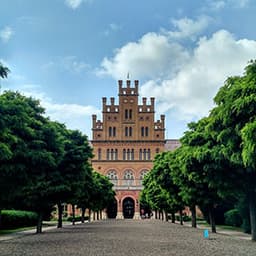Emergency lighting is one of the most important safety systems in a building. Emergency lighting makes it possible to safely stop working and evacuate a building by following the exit lights in the event of an emergency, including during a power cut.
Emergency lighting is strictly regulated in terms of both performance and positioning.
The term emergency lighting system describes the set of components that aim to provide appropriate marking and a minimum amount of lighting on the floor, in order to safely evacuate a public building, in case of emergency (e.g. earthquake). By the term "buildings of public use" we mean all those buildings in which people may be found, who are not familiar with their layout, such as hospitals, hotels, schools, office buildings, public services, etc.' As their name indicates, they are used for emergency reasons, in the event of a power outage in a facility (e.g. power outage due to damage, fire, earthquake, etc.).
In these cases they help people to evacuate a building or to live comfortably in situations of total darkness.
Their role is to provide the necessary and sufficient lighting in the space and to illuminate the signs indicating the escape routes of the building, so that it can be safely evacuated (in case of emergency) or comfortably stay inside it when the power is interrupted.
A. Non-maintained emergency luminaires:
These luminaires only work in case of interruption of the main power supply. They consist of a charging circuit, rechargeable batteries (usually ni-cd), a control circuit and an inverter to operate the lamp, if the fixture contains a fluorescent lamp.
B. Continuous operation emergency luminaires (maintained):
Luminaires of this type operate either from the main power source or from batteries, in the event of a main source failure, using the same lamp in both cases. They consist of a circuit to operate the lamp from the main power source (usually an electronic ballast), a charging circuit, rechargeable batteries (usually ni-cd), a control circuit and an inverter to operate the lamp, if the fixture contains a lamp fluorescence.
C. Sustained emergency luminaires:
Same as continuous operation, except that they use a different lamp to operate from the main power source and another to operate from the battery.
D. Central unit luminaires or dependent emergency luminaires (slave):
They are the lamps that do not have batteries for their operation, but depend on some other auxiliary voltage source (central unit). Dependent luminaires are characterized by their supply voltage. There are 12 or 24 v ac/dc models but also 230v ac/dc.
A. Self-checking emergency luminaires:
It is a special category of new technology emergency luminaires, with a microprocessor that controls the most basic parameters of their operation. In particular, Olympia Electronics' smart emergency luminaires control:
1. Constantly the correct charging, internal workings of their circuit and correct placement of the battery.
2. They automatically perform a check for the correct operation of their lamp, every 15 days.
3. They carry out a full discharge to check the autonomy, every 6 months. The self-checking lamps have three leds with which they show their status, so that with a simple visual check the maintainer of a building can know which lamps need maintenance and what kind of maintenance they need. Smart lamps are non-continuous, continuous and complex.
B. Addressable emergency luminaires:
They operate like smart lighting, with the exception that the controls are performed with commands given by a central control panel. The panel is programmed by the user for the type and timing of checks. The results of each check are recorded in the board's memory and can be read from its screen or printed on a printer. The installation of such system is certainly more complicated, but it has many advantages and offers control possibilities incomparably greater than a system with common emergency lighting.
C. Centrally powered and addressable emergency lighting (CBS – Central Battery Systems):
They work with the philosophy of smart luminaires, with the difference that these luminaires do not have batteries, but are powered and at the same time controlled by a central panel. The panel communicates with the luminaires through the same cables that power them. By performing some automatic checks, the user can see the status of all the luminaires at any time on the panel screen. Facilities of this type, among others
they have reduced maintenance requirements because the batteries and main control mechanisms are all located in the central panel. Also, these systems typically use batteries with a typical life of 10 years – unlike all other categories, where batteries have a typical life of 4 years.
They are connected to the PPC network (230 V) with a plug and are placed on a wall, suspended ceiling, etc.
Emergency luminaires vary in terms of their autonomy, the type of lamps they contain, the space they are made for and their price.
The main criteria for choosing the appropriate emergency light are:
1. The placement area
2. The light intensity
3. Autonomy
In addition, emergency luminaires are used in two cases:
1. To illuminate the direction sign affixed to them and
2. To provide light in emergency escape routes.
In the first case, continuous operation emergency luminaires are used, and in the second case, non-continuous operation.
There are two uses for which emergency lighting will be used in a building. The first use is signage, for which continuous operation luminaires are used and the aim is to give information about the direction someone should follow to safely leave the building. The second use of emergency lighting is to provide sufficient illumination at floor level so that the building can be evacuated safely. The luminaires for this use are intermittent and are placed in dangerous or critical areas.
Emergency luminaires are installed in places where they are visible and easy for people to see. The spaces in which they are installed are mainly spaces where overcrowding is likely to be created or there are dangerous elements such as stairs, sliding doors, level changes, etc.. For example, in a building, the emergency luminaires must be installed on its stairs, in such a way that in case of absolute darkness there is a sufficient amount of lighting so that the occupant can safely get out.
More specifically, they are placed in key points such as:
- Near an intersection of corridors
- Close to every change of direction
- Near emergency exits
- On the stairs so that each step receives sufficient lighting and in stairwells
- Close to every floor level change
- Near every alarm button
- Near fire extinguishing materials (e.g. Fire Extinguisher) and fire alarm
- Near first aid stations
- Outside and close to every final exit
- Near First Aid stations
"Near" is defined as a maximum distance of 2 meters horizontally from the point. These points must have luminaires with the appropriate sign.
Emergency luminaires with LED lamps have a longer autonomy time, due to the lower consumption of the LEDs. Also, energy and space are saved as LED lamps are smaller in size than fluorescent lamps, in addition they have 5-10 times longer life, do not heat up and are not sensitive to vibrations, shocks and strains.
The duration of autonomous operation of emergency luminaires must be enough to ensure the safe evacuation of each building in case of such a need appears. The minimum requirement set by the Greek specifications is 90 minutes (P.D. 71/88). Exceptions are health and welfare buildings (hospitals, clinics, health centers, etc.) where a minimum autonomy of 3 hours is required. In most foreign countries such as Germany, England, Arab countries, 3 hours autonomy is required.
Because emergency luminaires that are not manufactured in accordance with European legislation are considered expendable luminaires, with transformers of dubious origin, which are in no way recommended for use in building emergency, but only for private use, as "flashluminaires", as they are completely unsafe for use on escape routes.
For this reason OLYMPIA ELECTRONICS products comply with European new approach directives and European harmonization standards. As a result of the above, they carry the CE mark, while several of them also carry quality marks from internationally recognized certification bodies.
For simple emergency luminaires, it is recommended that at least once a month the operation of the lamp is checked by the control button (TEST) and once a year an autonomy check in the event of a power failure.
But there are also self-checking luminaires, which, as their name suggests, carry out the necessary checks of proper operation by themselves.
Yes, emergency luminaires are placed in public buildings and places of mass gathering and according to PD 71/88 regarding emergency Lighting it is stated that:
"For each building, where, according to its Special Provisions, emergency lighting is required on the escape routes, it must meet the following:
a. The interruption of lighting, during the change from one energy source to another, should be minimal. The permitted interruption should not exceed 10 seconds.
b. The emergency lighting must be supplied from a reliable back-up power source, so that a minimum value of 1 lux, measured at floor level, is ensured at all points on the floor of the escape routes.
c. The emergency lighting system must maintain the intended lighting for at least 1½ hours, in the event of interruption of normal lighting."
Such buildings are: residences (>50 people or 6 floors and >30 people), hotels, schools, offices, shops, public gathering places, industries, warehouses, health and welfare buildings, prison buildings, car parks, petrol stations.
Yes, emergency luminaires are placed in public buildings and places of mass gathering and according to PD 71/88 regarding emergency Lighting it is stated that:
"For each building, where, according to its Special Provisions, emergency lighting is required on the escape routes, it must meet the following:
a. The interruption of lighting, during the change from one energy source to another, should be minimal. The permitted interruption should not exceed 10 seconds.
b. The emergency lighting must be supplied from a reliable back-up power source, so that a minimum value of 1 lux, measured at floor level, is ensured at all points on the floor of the escape routes.
c. The emergency lighting system must maintain the intended lighting for at least 1½ hours, in the event of interruption of normal lighting."
Such buildings are: residences (>50 people or 6 floors and >30 people), hotels, schools, offices, shops, public gathering places, industries, warehouses, health and welfare buildings, prison buildings, car parks, petrol stations.





Emergency Lighting System